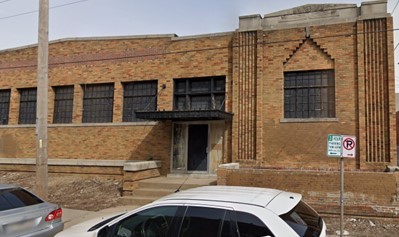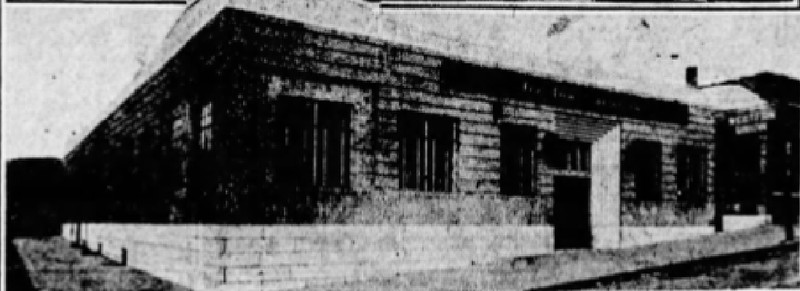Metro-Goldwyn-Mayer Studios Building
Introduction
Text-to-speech Audio
Kansas City's Metro-Goldwyn-Mayer Studios Building was constructed between 1929 and 1930 and is one of many buildings that supported major studios in an area of Kansas City once known as "Film Row." From the 1920s through the postwar era, Kansas City's Film row was part of a network of 32 "exchange centers" around the country that stored and distributed films. Other major film companies such as Walt Disney, Warner Brothers, and 20th Century Fox operated from their own buildings in Film Row while smaller companies rented offices in neighboring structures. The Metro-Goldwyn-Mayer Studios Building is located on the west side of Film Row, which encompasses the area between Central Street and Baltimore Avenue and between 17th and 20th Streets.
Images
Metro-Goldwyn-Mayer Studios built this facility in either 1929 or 1930 to house its film reels, which were stored and then distributed to theaters. Other studios built storage facilities in the area as well. As a result, Kansas City became one of the 32 film reel "exchange centers" around the country.

Metro-Goldwyn-Mayer Studio building (circa 1930)

Backstory and Context
Text-to-speech Audio
Kansas City and the other exchange centers were essential to the film industry between the 1920s and the 1970s. Kansas City's central location in the country and its status as a major railroad transportation hub made it an ideal place to store and distribute films to Midwestern theaters. These were needed beginning in the 1920s, which is when the film industry took off. During that decade, nearly a thousand films were produced each year, a number that continued to rise in the coming decades. All of this production generated vast amounts of films as the average Hollywood movie needed six to ten reels of film reels, and all of these had to be stored at exchange centers, which were also places where films could be repaired.
Metro-Goldwyn-Mayer Studios erected its building on Film Row between 1929 and 1930. Designed in the Art Deco style and built of brick, it had a capacity of 15,000 reels and also had a small theater. The studio owned the building until 1990. In 1992, the building was bought by a vacuum company that used it for storage.
While Metro-Goldwyn Mayer Studios experienced some of its greatest success in the late 1940s and 1950s with massive technicolor hits such as "Singin' in the Rain" (1952) or "Ben Her" (1959), so did the Kansas City office. This building was a center of what former Film Row employee Jack Poessiger considered one of the "greatest industry communities" in the city. Articles in The Kansas City Star report MGM's studio as being a local hang-out area for many exhibitors, even those who were not visiting to do business.
One of the more intriguing stories to come out of the era was the case of the disappearing film reels. In March of 1947, "The Kansas City Times" reported that roughly 24,000 feet of film was stolen from the sidewalk in front of the branch office. The branch's booking manager, Walter Lambader, warned the perpetrators that their theft endangered public safety. He remarked that the nitrate film that was stolen was highly flammable. He worried that anybody, especially a child, might cause unintentional harm to themselves if the films were not returned. The films were never recovered. The robbery of film reels in Kansas City was a rare occurrence. Lambader's comments support Poissiger's perspective that the employees of Film Row cared deeply about the magic of film and took responsibility for public welfare.
Cite This Entry
Grace Cogan, Ben M., and Clio Admin. "Metro-Goldwyn-Mayer Studios Building ." Clio: Your Guide to History. December 15, 2024. Accessed April 1, 2025. https://theclio.com/entry/156626
Sources
Associated Press. "Preservationists fight for MGM building in Kansas City." Columbia Missourian. July 16th, 2016. https://www.columbiamissourian.com/news/state_news/preservationists-fight-for-mgm-building-in-kansas-city/article_db2522de-6ff7-507d-8c97-222d2f7b90dc.html.
Dennis, Clarence. "Kansas City’s Crossroads has a Historic Tie to Hollywood." FlatlandKC. June 6, 2022. https://flatlandkc.org/curiouskc/kansas-city-film-row-links-crossroads-arts-district-to-hollywood.
Ihde, Ted. "Ever curious about why Kansas City has been so historically important to Hollywood?" Linkedin. April 25, 2020. https://www.linkedin.com/pulse/ever-curious-why-kansas-city-has-been-so-historically-ted-ihde.
"Two Movies Are Stolen." The Kansas City Times (Kansas City, Missouri) March 18th, 1947. , 3-3.
Photo from Google Streetview, 8/30/22
The Kansas City Star

